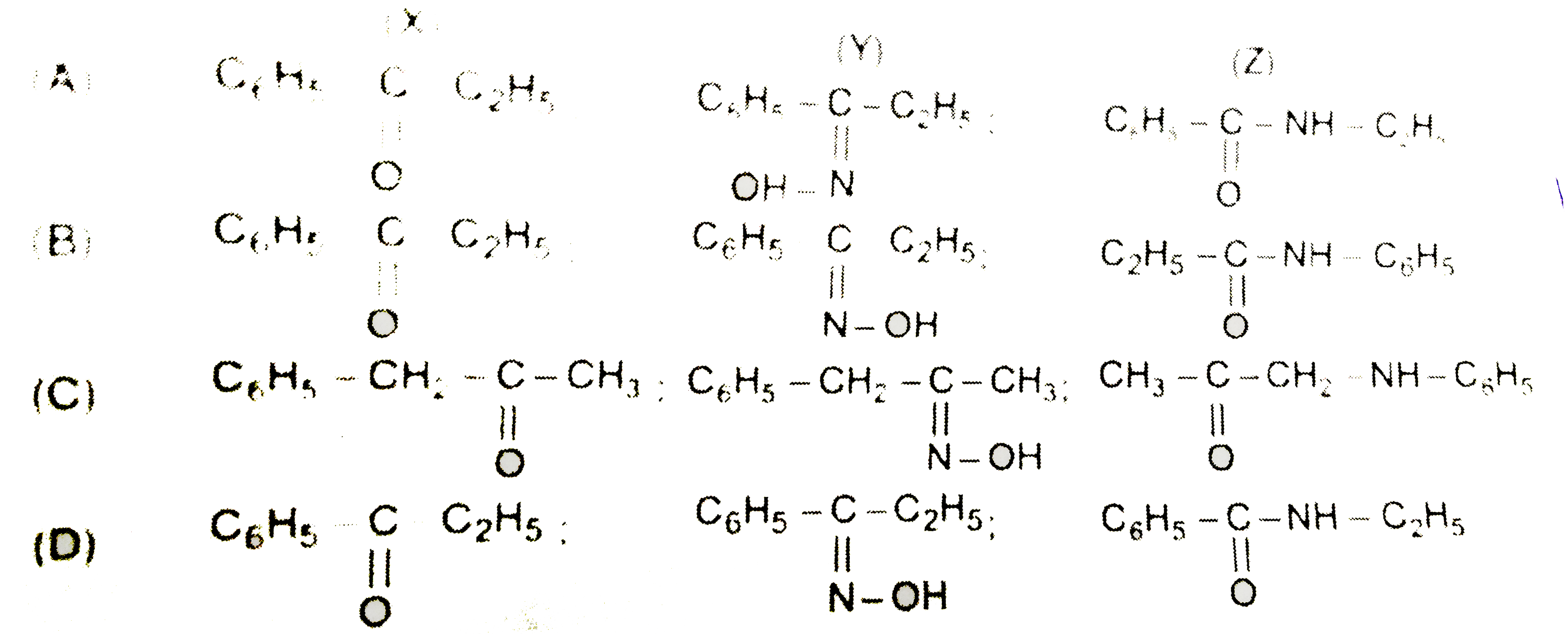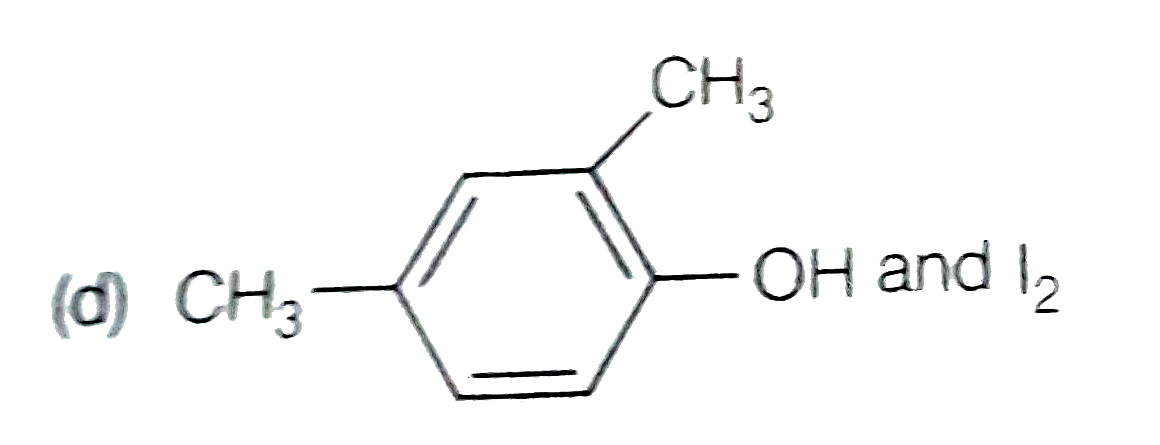X' compound (C4H8O) decolorises bromine water react with I2 & NaOH it give yellow ppt identify 'X'
CH3−O∣∣C−CH2−CH3
CH3−CH∣OH−CH=CH2
CH3−CH3∣C∣OH−CH3
CH3−HC=CH−CH2∣OH
The correct Answer is:B
To identify the compound X with the molecular formula C4H8O, we will follow these steps:
Step 1: Analyze the Molecular Formula
The molecular formula C4H8O indicates that the compound has 4 carbon atoms, 8 hydrogen atoms, and 1 oxygen atom. This suggests that the compound could be unsaturated (having double bonds) since the hydrogen count is lower than that of a saturated compound.
Hint: Look for the degree of unsaturation using the formula Degree of Unsaturation=(2C+2−H)2.
Step 2: Test for Unsaturation
The compound is said to decolorize bromine water, which is a test for unsaturation. This indicates that X must contain at least one double bond between carbon atoms (C=C).
Hint: Remember that alkenes and alkynes can decolorize bromine water due to their double or triple bonds.
Step 3: Identify Possible Structures
We will consider possible structures for C4H8O that can decolorize bromine water. The following structures could be considered:
1. Butene (C4H8)
2. 2-butanol (C4H10O)
3. 3-buten-2-ol (C4H8O)
4. 2-butanone (C4H8O)
Among these, we need to check which of these compounds can decolorize bromine water.
Hint: Focus on structures that contain C=C bonds.
Step 4: React with Iodine and Sodium Hydroxide
The question states that X reacts with iodine (I2) and sodium hydroxide (NaOH) to give a yellow precipitate. This reaction is characteristic of the iodoform test, which indicates the presence of a methyl ketone or a secondary alcohol with a methyl group adjacent to the hydroxyl group.
Hint: Look for compounds that can produce a yellow precipitate when treated with iodine and NaOH.
Step 5: Determine the Structure of X
Among the identified structures, we need to check which one can give a yellow precipitate:
- 2-butanol (secondary alcohol with a methyl group adjacent) will give a yellow precipitate.
- 2-butenone (methyl ketone) will also give a yellow precipitate.
However, since the compound must also decolorize bromine water, we can conclude that 2-butanol is the correct structure because it is a secondary alcohol that meets both criteria.
Hint: Verify the structure by checking if it meets both the unsaturation and iodoform test requirements.
Conclusion
Thus, the compound X is 2-butanol (or 2-butanone, depending on the context, but primarily 2-butanol fits both tests).
Final Answer: The compound X is 2-butanol.
The molecular formula C4H8O indicates that the compound has 4 carbon atoms, 8 hydrogen atoms, and 1 oxygen atom. This suggests that the compound could be unsaturated (having double bonds) since the hydrogen count is lower than that of a saturated compound.
The compound is said to decolorize bromine water, which is a test for unsaturation. This indicates that X must contain at least one double bond between carbon atoms (C=C).
We will consider possible structures for C4H8O that can decolorize bromine water. The following structures could be considered:
1. Butene (C4H8)
2. 2-butanol (C4H10O)
3. 3-buten-2-ol (C4H8O)
4. 2-butanone (C4H8O)
The question states that X reacts with iodine (I2) and sodium hydroxide (NaOH) to give a yellow precipitate. This reaction is characteristic of the iodoform test, which indicates the presence of a methyl ketone or a secondary alcohol with a methyl group adjacent to the hydroxyl group.
Among the identified structures, we need to check which one can give a yellow precipitate:
- 2-butanol (secondary alcohol with a methyl group adjacent) will give a yellow precipitate.
- 2-butenone (methyl ketone) will also give a yellow precipitate.
Thus, the compound X is 2-butanol (or 2-butanone, depending on the context, but primarily 2-butanol fits both tests).
Topper's Solved these Questions
- BOOK - RESONANCE ENGLISHCHAPTER - STRUCTURAL IDENTIFICATION & PRACTICAL ORGANIC CHEMISTRYEXERCISE - Additional theory4videos
STRUCTURAL IDENTIFICATION & PRACTICAL ORGANIC CHEMISTRY
- BOOK - RESONANCE ENGLISHCHAPTER - STRUCTURAL IDENTIFICATION & PRACTICAL ORGANIC CHEMISTRYEXERCISE - Additional Exercise15videos
STRUCTURAL IDENTIFICATION & PRACTICAL ORGANIC CHEMISTRY
- BOOK - RESONANCE ENGLISHCHAPTER - STRUCTURAL IDENTIFICATION & PRACTICAL ORGANIC CHEMISTRYEXERCISE - APSP30videos
STRUCTURAL IDENTIFICATION & PRACTICAL ORGANIC CHEMISTRY
- BOOK - RESONANCE ENGLISHCHAPTER - SOLID STATEEXERCISE - Part- IV21videos
SOLID STATE
- BOOK - RESONANCE ENGLISHCHAPTER - THERMODYNAMIC & THERMOCHEMISTRYEXERCISE - INORGANIC CHEMISTRY(P-Block Elements)26videos
THERMODYNAMIC & THERMOCHEMISTRY
Similar Questions
Knowledge Check
- Question 1 - Select One
A compound X declourises Br2 water and reacts slowly with conc H2SO4 to give an addition product. X reacts with HBr to form Y. Y reacts with NaOH to form Z. on oxidation Z gives hexan-3-one. X, Y and Z in the reactions are
X↓conc. H2SO4Addition productBr2 water−−−−−→Decolourisation
XHBr−−→YNaOH−−−→Z[O]−−→CH3CH2CH2−C∣∣O−CH2CH3Hexan-3-oneAX=CH3CH2CH=CHCH3,Y=CH3CH2CH(Br)CH(Br)CH2CH3,Z=CH3CH2CH3BX=CH3CH=CHCH3,Y=CH3CH(Br)CH(Br)CH3,Z=CH3CH2CH2OHCX=CH3CH2CH=CHCH2CH3,Y=CH3CH2−C∣BrH−CH2CH2CH3,Z=CH3CH2CH2−C∣OHH−CH2CH3DX=CH3CH2CH2CH=CHCH3,Y=CH3CH2CH2CH2CH2CH2Br,Z=CH3CH2CH2CH2OH - Question 2 - Select One
Compound (X) C4H8O, which reacts with 2,4-DNP derivative and gives negative haloform test is :
ACH3−O∣∣C−CH2−CH3BCH3−CH∣CH3−CHOC DCH3−CH2−OH∣CH−CH3
DCH3−CH2−OH∣CH−CH3 - Question 3 - Select One or More
Unknown compound (A) C5H10O give positive test with 2,4 - DNP
but negative test with Tollen's reagent. It also give yellow precipitate with I2/NaOH . (A) is :A B
B C
C D
D
A benzenoid organic compound A(C8H8O) gives B and white crystalline solid C with Cl2 and NaOH. On heating compound B gives a compound with unpleasant smell with CH3−CH2−NH2 and alcoholic KOH. Compound A is
View SolutionA compound 'D' (C8H16O) has following observation
(a) It reacts with Lucas reagent with in 5min.
(b) On heating in presence of acid given a compound X, which can decolorize KMnO4 as well as Br2/Cl4.
(c ) compound Xozonolysis−−−−−→YI2/NaOH−−−−−→2 moles of iodoform + sodium salt of dibasic acid Sodalime−−−−→n− butane
Then D, X, Y areView SolutionCompound (X) C6H5O gives yellow coloured ppt with 2,4 DNP but does not give red colored ppt with Fehiling's solution (X) on treatement with NH2OHH+ gives compound (Y) C6H5NO (Y) when treated with PCl5 gives isomeric compound (Z) . (Z) on hydrolysis gives propanoic acid and aniline. what will be the correct structure of (X) ,(Y) and (Z) ?
 View Solution
View SolutionCompound A,C8H10O, is found to react with NaOI (produced by reacting Y with NaOH) and yields a yellow precipitate with characteristic smell.
A and Y are respectively
(a)
(b)
(c)
(d) View Solution
View SolutionAn aromatic compound A of the molecular formula C8H10O on reaction with iodine and dilute NaOH gives a yellow precipitate. The structure of the compound is expected to be :
View Solution

